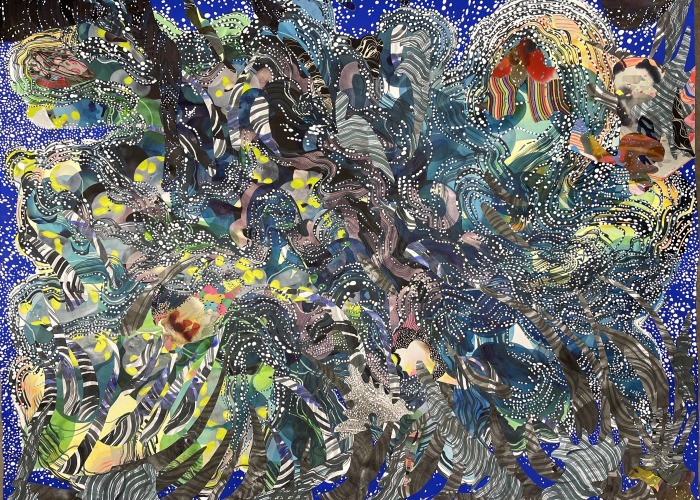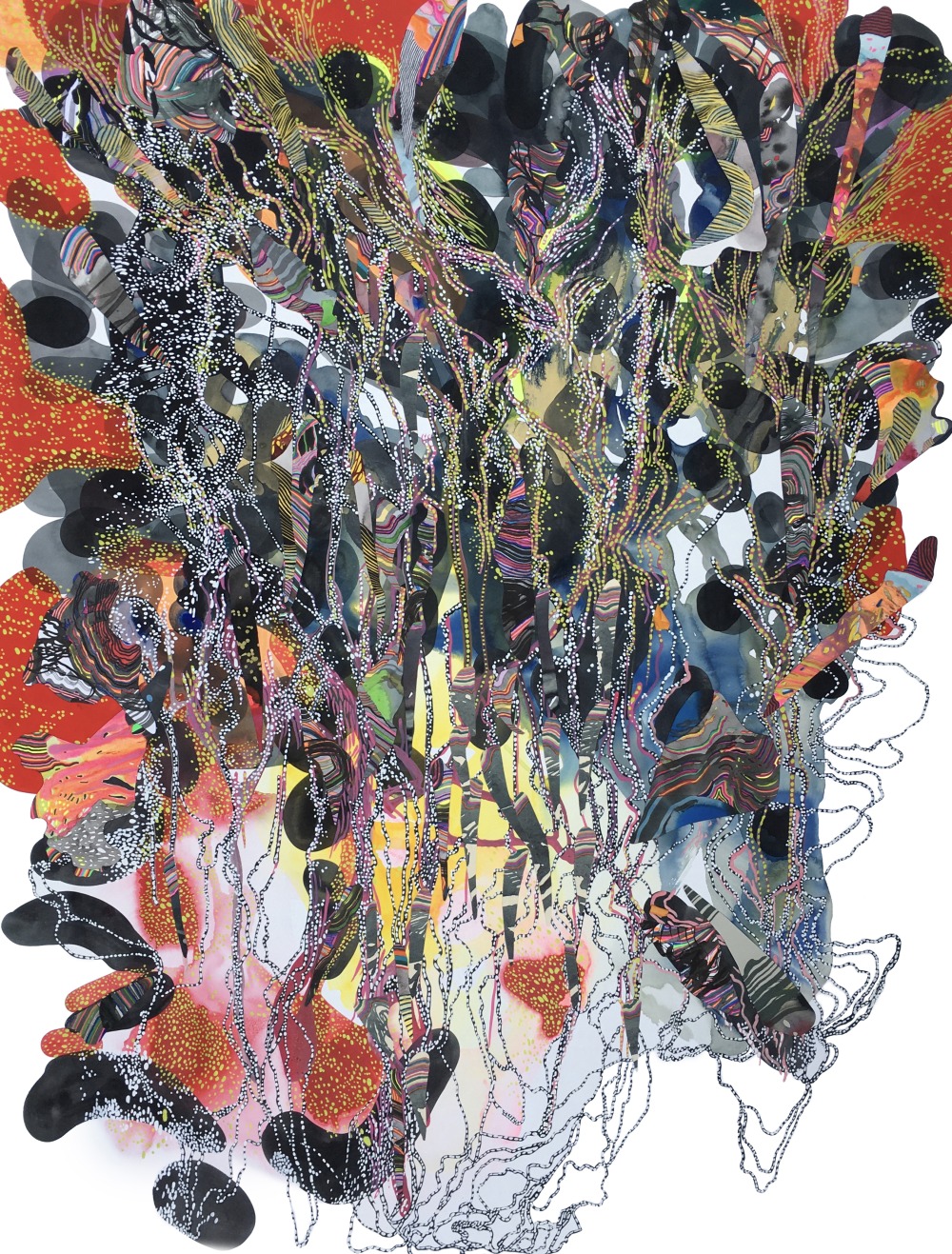River Deep - Mountain High by Anne Austin Pearce
Essay written by guest curator Cara Megan Lewis

Pearce’s studies of natural phenomena remind us that life finds a way despite the perceived limitation that death presents. Death is not the end as life courses forward in the universe’s continuous cycle.
Draw in.
Five miles away—as the crow flies—the tide pools along the coast are emptying and filling in equal measure to your breath. Meanwhile, the neon tentacles of a million anemones undulate at this very moment in silent synchronicity with the cilia of your lungs. In a mysterious quantum-entangled choreography, all is connected.
Anne Austin Pearce has been an interpreter of the invisible connective energy shared between species for decades. Her work articulates this interconnectedness one small pool of pigment at a time, employing a bold interplay of ink, watercolor, collage, and iridescent marks. Pearce’s works on paper range in size from that of a dresser mirror to a reflecting pond, each surface offering up a feast of dense rhythms, articulating worlds known but unseen.
Upon moving to California from Kansas City in 2020, Pearce found inspiration in the vast abyss of the ocean, and her work further evolved towards abstraction from a practice that was once grounded firmly in the human form. Pearce’s early works on paper were centered on the figure and specifically on the threshold membrane of the skin and hair as a container for the intangible entities of emotion, grief, generational knowledge, and trauma. In the work made over the last few years, the human form and its layered complexities seem to have been subsumed by the larger flow of life intermingling with all other living matter in a churning and tumbling broth. Imagine your fragmented likeness reflecting on the surface of a pond.
It is fulfilling to approach Pearce’s highly energetic, layered, and densely populated abstractions as you would a tide pool, allowing shapes and contours to emerge slowly and in their own time. Below the rivulets of the surf, what do you see? Is it the coiled finger of an octopus or the glossy shield of a rock crab? Could this oozing drip be bioluminescent algae tossed in the ocean’s swell?
As you allow the works to wash over you, you will begin to notice Pearce’s lexicon of mark-making. Among the washes of ink and rendered contours, a series of squiggly parallel lines dart in and among the folds of jewel-tone colors. A weblike net is another recurring motif formed within the negative space of an ink droplet left to find its way across a dry paper surface. And finally, there are the schools of dots that articulate dimension, making order in some places and creating chaotic rhythms in others. These dots echo the patterns of Aboriginal art, such as that of the 1970s Papuya Tula cooperative of artists like Emily Kane Kngwarreye, who used dots to render the shimmer of water.
Pearce comes from a deep lineage of abstract artists across history and geography who have translated the essence of specific places through abstraction. Abstract Expressionist painter Mary Abbott (1921 - 2019) repeatedly captured the lush environment and light variations of her garden as well as her travels to Saint Croix and Haiti. Her paintings capture not the physical likeness of a place but rather the emotional responses they elicit. An earlier AbEx painter, Arshile Gorky (1904-1948)—who, like Pearce, evolved from figuration to abstraction—experienced a pivotal breakthrough in his work upon an intense study of the running of water over rocks at the base of an abandoned mill in Connecticut. Captivated by the strange shapes formed within the splashing, his paintings in the early 1940s sought to evoke this explosive energy.
A similar eruptive vitality can be found here in Pearce’s Icarus, a wall drawing that breaks the picture plane to encompass the elements of the gallery’s architecture, including columns and window nooks. Comprised of fragments of Pearce’s previous works on paper, the immersive installation is splintered and woven back together; here, pieces of once jettisoned drawings are given new life. Icarus’ movement through space references the mythical figure who, in overconfidence, ignored Daedelus’ caution to fly too close to the sun—a metaphor for dashed dreams and hopes. In Pearce’s interpretation, the dashed dreams are not lost to the ocean’s abyss but absorbed by the waters and carried on in the wake.
Pearce’s sensory experiences transcend time and species. She once expressed in an interview, “I can feel the telltale hearts of wooly mammoths, smell the green, fresh ferns, and hear the yet-to-be-discovered hearths of the long-dead beat again inside of me.” If the Dutch tradition of still life was to remind us of our own mortality, Pearce’s studies of natural phenomena remind us that life finds a way despite the perceived limitation that death presents. Death is not the end as life courses forward in the universe’s continuous cycle.
Founders Gallery Page Watch Anne’s Coastline College Interview

